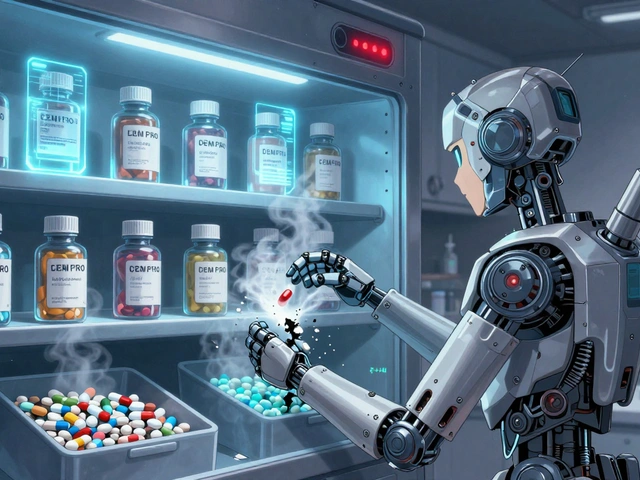When a drug company wants to make a generic version of a pill that contains two active ingredients - like blood pressure meds that combine an ACE inhibitor with a diuretic - they can’t just copy the formula and call it done. That’s where bioequivalence comes in. But for combination products, proving that the generic works the same way as the brand-name version isn’t just harder. It’s often a maze of technical, regulatory, and financial obstacles that can delay generic access by years.
What Makes Combination Products Different?
Combination products aren’t just two drugs in one pill. They’re complex systems: fixed-dose combinations (FDCs), topical creams with multiple actives, inhalers that mix drug and device, or injectors with built-in sensors. Each component can affect how the other behaves in the body. For example, one drug might change the solubility of the other, or the delivery device might alter how much drug actually reaches the bloodstream. The FDA requires generic versions to match the reference product in both rate and extent of absorption. For a single-drug tablet, that’s usually done with a simple crossover study in 24 healthy volunteers. But for a combination product? You might need 40-60 people, multiple blood draws over days, and tests for each active ingredient separately - all while controlling for interactions that could skew results.Fixed-Dose Combinations: When Two Drugs Don’t Behave Like One
Take a common FDC like metformin and sitagliptin for type 2 diabetes. Each drug has its own absorption profile. When combined, one might slow down the other’s release. That’s not a flaw - it’s often intentional. But for generics, it’s a nightmare. The FDA now requires generic makers to prove bioequivalence to both the original FDC and the individual drugs taken together. That means running three-way crossover studies: one arm with the brand FDC, one with the brand mono-drugs taken at the same time, and one with the generic. It’s expensive, time-consuming, and statistically complex. Studies show that FDC bioequivalence trials fail 25-30% more often than single-drug trials. Why? Formulation interactions. One ingredient might bind to the other, change its crystalline structure, or alter its dissolution rate. Teva Pharmaceuticals reported that 42% of their complex product development failures were tied to bioequivalence issues - mostly with modified-release FDCs.Topical Products: Measuring What You Can’t See
Creams, ointments, and foams for eczema, psoriasis, or fungal infections are another major category. The challenge? You can’t just measure drug levels in blood. The active ingredient needs to reach the skin’s outer layer - the stratum corneum - to work. The FDA’s current method uses tape-stripping: peeling off 15-20 layers of skin with adhesive tape, then analyzing how much drug is in each layer. But here’s the problem: no one agrees on how deep to go, how much tape to use, or how to standardize the process across labs. One lab’s “deep” might be another’s “shallow.” This lack of standardization leads to inconsistent results. Mylan (now Viatris) spent years trying to get a generic calcipotriene/betamethasone foam approved. Three bioequivalence studies failed - not because the drug didn’t work, but because the measurements varied too much between trials. Clinical endpoint studies for topical products - where you actually measure skin improvement in patients - can cost $5-10 million and take over two years. Most generic companies can’t afford that. So they’re stuck between regulatory uncertainty and financial ruin.
Drug-Device Combos: The Invisible Hurdle
Inhalers, auto-injectors, and nasal sprays are drug-device combinations (DDCPs). The drug might be perfect - but if the device delivers it differently, the patient gets less (or more) than intended. For inhalers, the key metric is aerodynamic particle size distribution. The FDA requires generic inhalers to deliver 80-120% of the reference product’s particles in the right size range. Sounds simple? It’s not. A 0.5-micron difference in particle size can mean the difference between the drug reaching the lungs or getting stuck in the throat. But here’s the real kicker: 65% of complete response letters from the FDA for DDCPs cite problems with the user interface. That means the inhaler’s mouthpiece shape, the button’s resistance, the spray timing - even how it feels in the hand - can trigger rejection. Generic manufacturers don’t just need to match the drug. They need to replicate the user experience perfectly.Why the System Is Broken - And Who’s Paying the Price
The current bioequivalence framework was built for simple tablets. It wasn’t designed for products where the delivery system is as important as the chemistry. Dr. Lawrence Yu from the FDA admitted in 2023 that “the one-size-fits-all approach no longer works.” And he’s right. The data shows it:- Complex product ANDAs take 38.2 months to approve - nearly three times longer than standard generics.
- 89% of generic companies say current requirements are “unreasonably challenging.”
- Small and mid-sized manufacturers are hit hardest. They lack the $300,000-$500,000 LC-MS/MS machines and teams of trained scientists needed to run these tests.

Solutions on the Horizon
There’s hope. The FDA has started shifting away from one-size-fits-all testing. One major advance is physiologically-based pharmacokinetic (PBPK) modeling. Instead of running dozens of human trials, companies can simulate how the drug behaves in different body types using computer models. PBPK has been accepted in 17 approved ANDAs since 2020, cutting clinical studies by 30-50%. Another is in vitro-in vivo correlation (IVIVC) for topical products. Researchers are now linking tape-stripping data to actual skin response in patients. Pilot studies show 85% accuracy in predicting how a cream will perform in people - based purely on lab tests. If this scales, it could cut development time by years. The FDA’s Complex Product Consortium has already created 12 product-specific bioequivalence guidances. That’s a big step. Each guidance tells companies exactly what tests to run - no guesswork. The agency plans to issue 50 more by 2027, starting with respiratory products where 78% of submissions currently fail.What’s Next?
The future of bioequivalence for combination products won’t be about bigger studies. It’ll be smarter science. We’re moving toward:- Product-specific guidances that replace vague general rules
- Standardized reference materials from NIST to reduce lab-to-lab variability
- AI-driven PBPK models that simulate thousands of virtual patients
- Harmonization between FDA and EMA to avoid duplicate testing
Why can’t generic companies just copy the brand’s formula for combination products?
Because the way ingredients interact in a combination product isn’t just about chemistry - it’s about how they’re formulated together. One drug might change how the other dissolves, absorbs, or even degrades. A generic manufacturer can’t just swap in identical ingredients; they have to prove the entire system behaves the same way in the body. That often requires new formulations, new testing methods, and sometimes even new devices.
What’s the biggest reason generic combination products get rejected by the FDA?
For drug-device combos like inhalers or injectors, the top reason is deficiencies in user interface testing. Even if the drug dose is correct, if the device feels different - the button is harder to press, the spray timing is off, or the mouthpiece shape changes - the FDA considers it a different product. For topical products, inconsistent drug penetration measurements are the main issue. For FDCs, it’s often failure to prove bioequivalence for both active ingredients simultaneously under all conditions.
How much does it cost to develop a generic combination product?
Developing a generic combination product typically costs $15-25 million and takes 3-5 years. Bioequivalence testing alone accounts for 30-40% of that cost. For topical or drug-device products, clinical endpoint studies can add another $5-10 million. That’s 10-20 times more than a standard generic tablet.
Are there any shortcuts to proving bioequivalence for complex products?
Yes - but only if the FDA accepts them. Physiologically-based pharmacokinetic (PBPK) modeling is now accepted in 17 approved cases and can replace up to half of human trials. In vitro-in vivo correlation (IVIVC) for topical products is also gaining traction. Early FDA meetings (Type II meetings) are critical to agree on a testing pathway before spending millions on studies.
Why do some combination products still have no generic versions after 10+ years?
Because the science and regulatory pathways haven’t caught up. Many complex products - especially advanced inhalers, combination dermatology creams, or modified-release FDCs - lack clear FDA guidance. Without a defined testing path, companies can’t confidently invest. Patent litigation also delays entry. The result: patients pay high prices, and innovation stalls.







Shivam Goel
November 24, 2025 AT 21:25Let’s be real-bioequivalence for FDCs is a regulatory nightmare. You need three crossover studies? For one pill? And you’re telling me a 0.5-micron particle size difference in an inhaler gets you a complete response letter? The FDA’s still operating on 1980s logic. Teva’s 42% failure rate? That’s not incompetence-that’s systemic sabotage. We’re paying $10k/month for brand-name inhalers while generics sit in limbo because someone thinks a button’s resistance matters more than patient outcomes.
Andrew McAfee
November 26, 2025 AT 03:46My dad’s on a combo blood pressure med and the generic cost him $20 a month before it disappeared from shelves. Now it’s $180. No one talks about this but it’s killing people. We got generics for statins and metformin but not for the combo pills that actually keep folks out of the ER? That’s not science that’s greed wrapped in a white coat
Elise Lakey
November 26, 2025 AT 21:48I’m fascinated by the PBPK modeling angle. It feels like we’re finally moving from brute-force human trials to predictive science. If we can simulate thousands of virtual patients with different metabolisms, organ function, even gut microbiomes-why are we still forcing companies to test on 60 real humans? It’s inefficient and ethically questionable. The data’s there. The tech’s ready. Why the delay?
Sharley Agarwal
November 28, 2025 AT 18:31This is why India’s generic industry will never dominate complex products. Too much science. Too little hustle. You think we can afford LC-MS/MS machines? We can’t even afford to fix our own water supply. This isn’t innovation. It’s a luxury for rich countries.
Srikanth BH
November 30, 2025 AT 11:14There’s hope here. Really. PBPK and IVIVC aren’t just tech-they’re justice. Imagine a world where a small manufacturer in Pune or Lagos can simulate a drug’s behavior instead of begging for $500k in lab equipment. This isn’t about big pharma vs small. It’s about access. If we get this right, millions get affordable meds. Let’s not waste this moment.
Kimberley Chronicle
December 1, 2025 AT 14:07From a pharmacokinetic standpoint, the lack of harmonized reference materials for tape-stripping in topical products is a catastrophic source of inter-laboratory variability. Without NIST-traceable standards, IVIVC models remain probabilistic rather than deterministic. The EMA’s recent draft on dermal bioequivalence offers a framework-why isn’t the FDA adopting it? Siloed regulation is the silent killer of generic innovation.
Shirou Spade
December 3, 2025 AT 05:57What if the problem isn’t the science but the assumption that bioequivalence must mirror the brand? What if the goal isn’t to copy but to achieve therapeutic equivalence through different means? We’ve done this with biosimilars-why not here? Maybe the real barrier isn’t technical. Maybe it’s philosophical. We’re obsessed with replication instead of reimagining.
Lisa Odence
December 3, 2025 AT 22:36OMG this is SO important!! 😭 I just read this entire thing and I’m crying because my sister has asthma and her inhaler costs $600 a month!! The FDA is literally letting people suffer because they won’t update their 1990s guidelines?? 🤯 PBPK modeling is like AI for medicine?? And they’ve already approved 17 ANDAs?? WHY ISN’T THIS ON THE NEWS?? We need a movement!! #GenericAccessNow #PBPKRevolution 🚨💉
Agastya Shukla
December 5, 2025 AT 22:14The user interface rejection rate for DDCPs-65%-isn’t a regulatory flaw. It’s a design flaw. The FDA is treating a drug-device combo like a black box, when it’s actually a human-machine interaction problem. If a patient can’t use it correctly, does bioequivalence even matter? We need human factors engineering baked into the approval pathway-not as an afterthought, but as a core pillar. This isn’t pharmacology. It’s ergonomics with a syringe.
Leisha Haynes
December 7, 2025 AT 07:13So let me get this straight-we spend $25M to make a generic inhaler, and the FDA rejects it because the button clicks a little louder? 😂 Meanwhile, the brand keeps raising prices because they know we’re stuck. The real bioequivalence test isn’t in the lab. It’s in the patient’s wallet. And guess what? They’re failing. Badly.